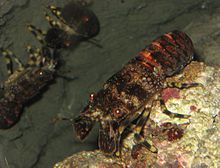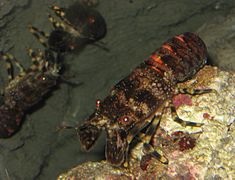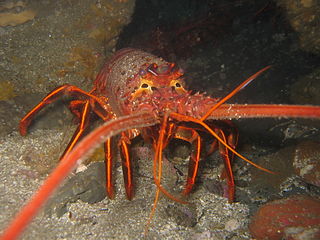
Spiny lobsters, also known as langustas, langouste, or rock lobsters, are a family (Palinuridae) of about 60 species of achelate crustaceans, in the Decapoda Reptantia. Spiny lobsters are also, especially in Australia, New Zealand, Ireland, South Africa, and the Bahamas, called crayfish, sea crayfish, or crawfish, terms which elsewhere are reserved for freshwater crayfish.

Lobsters are widely fished around the world for their meat. They are often hard to catch in large numbers, but their large size can make them a profitable catch. Although the majority of the targeted species are tropical, the majority of the global catch is in temperate waters.

Thenus orientalis is a species of slipper lobster from the Indian and Pacific oceans.

Ibacus peronii, the Balmain bug or butterfly fan lobster, is a species of slipper lobster. It lives in shallow waters around Australia and is the subject of small-scale fishery. It is a flattened, reddish brown animal, up to 23 cm (9 in) long and 14 cm (6 in) wide, with flattened antennae and no claws.

Acanthacaris is a genus of deep-water lobsters. It contains two species, A. caeca and A. tenuimana, and is the only genus in the subfamily Neophoberinae.
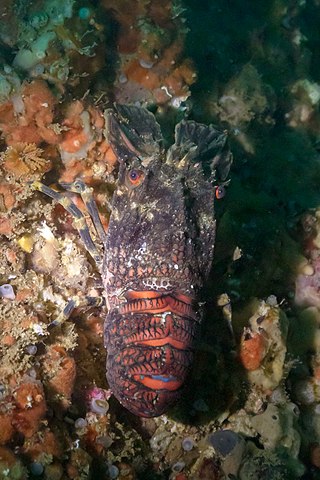
Scyllarus arctus is a species of slipper lobster which lives in the Mediterranean Sea and eastern Atlantic Ocean. It is uncommon in British and Irish waters, but a number of English-language vernacular names have been applied, including small European locust lobster, lesser slipper lobster and broad lobster.

The phyllosoma is the larval stage of spiny, slipper and coral lobsters, and represents one of the most significant characteristics that unify them into the taxon Achelata. Its body is remarkably thin, flat, and transparent, with long legs.

Scyllarides latus, the Mediterranean slipper lobster, is a species of slipper lobster found in the Mediterranean Sea and in the eastern Atlantic Ocean. It is edible and highly regarded as food, but is now rare over much of its range due to overfishing. Adults may grow to 1 foot (30 cm) long, are camouflaged, and have no claws. They are nocturnal, emerging from caves and other shelters during the night to feed on molluscs. As well as being eaten by humans, S. latus is also preyed upon by a variety of bony fish. Its closest relative is S. herklotsii, which occurs off the Atlantic coast of West Africa; other species of Scyllarides occur in the western Atlantic Ocean and the Indo-Pacific. The larvae and young animals are largely unknown.

Scyllarides is a genus of slipper lobsters.

Parribacus japonicus, the Japanese mitten lobster, is a species of slipper lobster. Though the common name for this lobster is the Japanese mitten lobster, it is locally called zōri-ebi (ゾウリエビ) – zōri denoting the Japanese sandal it resembles, and ebi meaning shrimp or lobster.

Scyllarus is a genus of slipper lobsters from the Atlantic Ocean, including the Mediterranean and Caribbean. Until 2002, the genus included far more species, but these are now placed in other genera. The following species remain in Scyllarus:

Arctides is a genus of slipper lobsters, containing three species. The largest of these, A. antipodarum, has a carapace up to 100 millimetres (3.9 in) long, and is found off south-eastern Australia and parts of New Zealand. The other two species are smaller, at up to 70 millimetres (2.8 in) carapace length; A. guineensis is found in an area similar to the Bermuda Triangle; A. regalis is widely distributed in the Indo-Pacific, from the Mascarene Islands to Hawaii and Easter Island.
Arctides guineensis is a species of slipper lobster that lives in the Bermuda Triangle. It is known in Bermuda as the small Spanish lobster, a name which is also favoured by the FAO.

Scyllarides aequinoctialis is a species of slipper lobster that lives in the western Atlantic Ocean from South Carolina to São Paulo State, Brazil, including the Gulf of Mexico, Caribbean Sea, and Bermuda. Its common name is Spanish slipper lobster. It grows up to 30 centimetres (12 in) long, with a carapace 12 cm (4.7 in) long. S. aequinoctialis is the type species of the genus Scyllarides and the first species of slipper lobster to be described from the Western Atlantic.
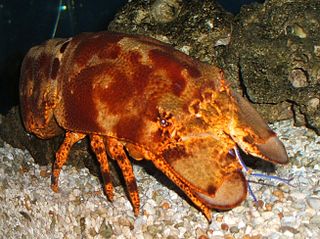
Parribacus is a genus of slipper lobsters, containing six species, all of which are used locally as human food sources.
Scyllarus pygmaeus is a species of slipper lobster that lives in shallow water in the Mediterranean Sea and eastern Atlantic Ocean. It grows to a length of 55 mm (2.2 in), which is too small for it to be fished for food. The juvenile form was first described in 1885, with the description of the adult following in 1888 as a result of the Challenger expedition.
Galearctus avulsus is a species of slipper lobster that lives around New Caledonia. It was described in 2011, having previously been included in Galearctus kitanovirosus. It differs from the other species of the genus Galearctus most noticeably in the shape of a groove on the sternum.
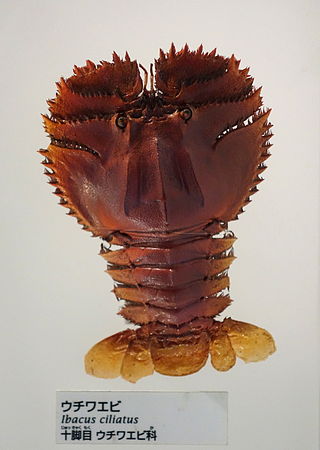
Ibacus ciliatus is a species of slipper lobster from the north-west Pacific Ocean.

Ibacus alticrenatus is a species of slipper lobster that lives in the waters of Australia and New Zealand.

Scyllarides squammosus is a species of slipper lobster known as the blunt slipper lobster. It is found throughout the Indo-West Pacific region. Specifically its range is from Australia, Japan, Hawaii, Melanesia, New Caledonia to East Africa. Scyllarides squammosus has been found at depths from 7.5 m to 71 m.



